Under Mexico City
Templo Mayor
By ROGER ATWOOD
Monday, June 09, 2014
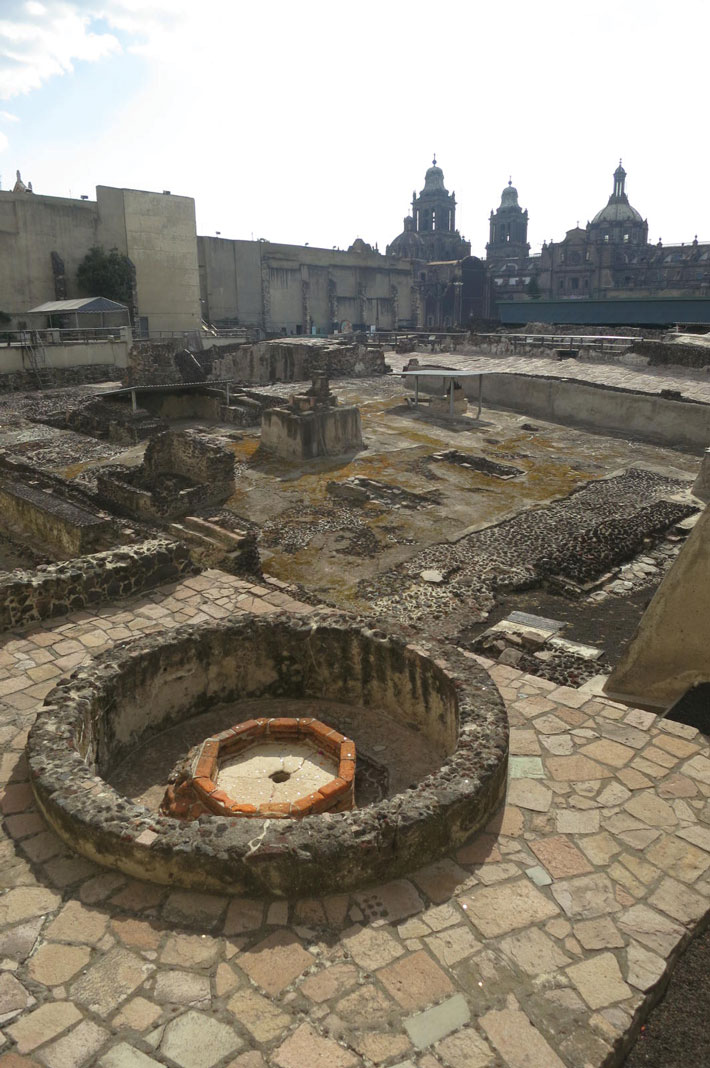 When the Spaniards arrived in Tenochtitlan in 1519, the Aztec capital’s main shrine stood 150 feet high. Little still stands of that building today because the Spaniards demolished it and used its blocks to build their own cathedral, known as the Metropolitan Cathedral of the Assumption of Mary, within sight of the remains of the once soaring temple. Possibly unknown to the Spaniards, however, at least six earlier versions of the Templo Mayor still lay underneath the structure they destroyed, the result of each successive ruler building his own temple on top of the previous one.
When the Spaniards arrived in Tenochtitlan in 1519, the Aztec capital’s main shrine stood 150 feet high. Little still stands of that building today because the Spaniards demolished it and used its blocks to build their own cathedral, known as the Metropolitan Cathedral of the Assumption of Mary, within sight of the remains of the once soaring temple. Possibly unknown to the Spaniards, however, at least six earlier versions of the Templo Mayor still lay underneath the structure they destroyed, the result of each successive ruler building his own temple on top of the previous one.
Since the early 1980s, archaeologists have been delving into those earlier layers, gaining a look at how the Aztecs worshipped decades before the conquest. Because these remains had been buried since the 1400s, they are giving researchers an unprecedented look at classical Aztec society. One of the first artifacts they excavated was a monumental stone disk dating from an early phase of the temple’s construction, around 1400, depicting the moon goddess Coyolxauhqui, a figure from the Aztec creation myth. In the legend, the goddess was decapitated and dismembered at the hands of her brother Huitzilopochtli as punishment for disrespecting their pregnant mother. Archaeologists have concluded from the chopped-off human limbs and heads excavated near the temple’s base that the grisly scene was reenacted regularly at Huitzilopochtli’s altar on the summit. Rows of skulls made of stone and stucco, still visible today, had their counterparts in actual skulls excavated nearby.
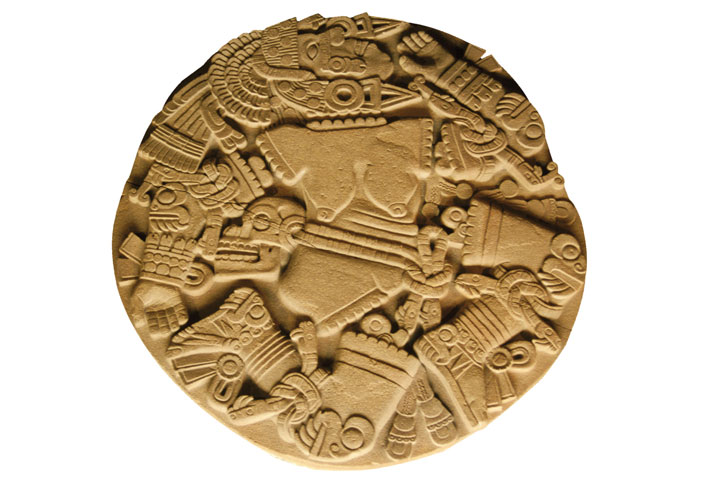 The carnal nature of Aztec worship has long intrigued researchers, in part because its focus on blood-drenched sacrifice in the public square had few parallels in other Mesoamerican societies. Scholars suggest that the elites may have felt insecure in their power, and responded with these grandiose, intimidating rituals. “You get a sense of who ran society and how they made themselves loom large over it, monumentalizing themselves, and how they expressed power with these acts,” says Harvard University historian David Carrasco. Sacrifice was also closely linked to warfare—the victims were mostly battlefield captives—and thus to economic domination over neighboring states, explains archaeologist Eduardo Matos Moctezuma.
The carnal nature of Aztec worship has long intrigued researchers, in part because its focus on blood-drenched sacrifice in the public square had few parallels in other Mesoamerican societies. Scholars suggest that the elites may have felt insecure in their power, and responded with these grandiose, intimidating rituals. “You get a sense of who ran society and how they made themselves loom large over it, monumentalizing themselves, and how they expressed power with these acts,” says Harvard University historian David Carrasco. Sacrifice was also closely linked to warfare—the victims were mostly battlefield captives—and thus to economic domination over neighboring states, explains archaeologist Eduardo Matos Moctezuma.
The greatest Aztec conqueror of them all, Ahuítzotl, was cremated upon his death in 1502 and his ashes placed in an urn at the base of the temple, according to sixteenth-century accounts. Archaeologists thought they might be close to finding his remains in 2006 when they excavated a stone inscribed with the year 10 Rabbit in the Aztec system (which corresponds to A.D. 1502) along with artifacts suggesting an elite burial. They now think that the urn with Ahuítzotl’s ashes had actually been dug up in 1900 by Mexican archaeologist Leopoldo Batres, who did not know he’d struck the Templo Mayor. At that time, the neighborhood around the buried ruins had few houses and a reputation for bad omens and ill spirits, likely a remnant of the site’s bloody history, says archaeologist Raúl Barrera.
Plaza Manuel Gamio
By ROGER ATWOOD
Monday, June 09, 2014
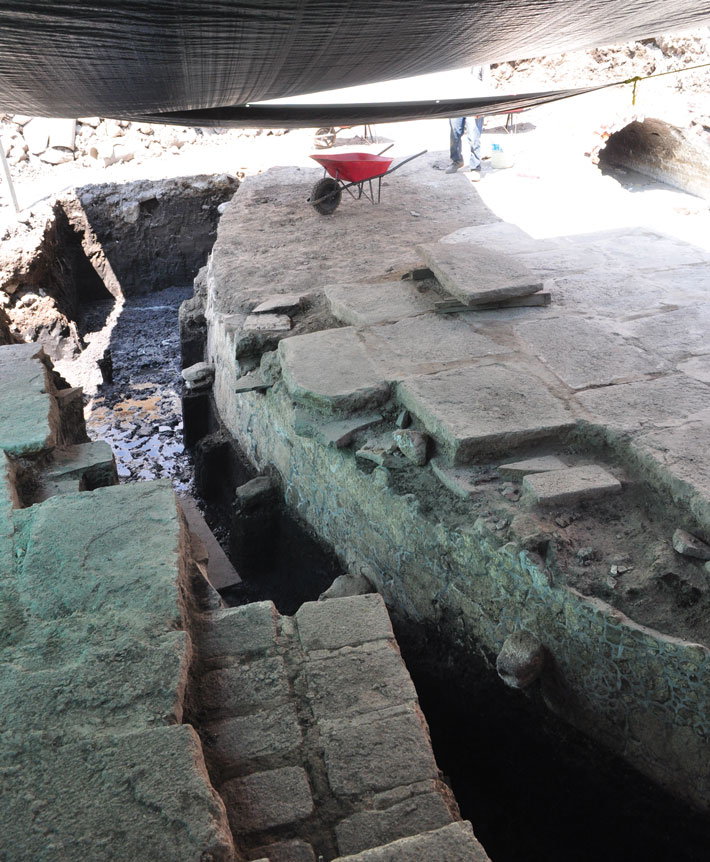 Despite their reputation for violence, the Aztecs had a finely honed taste for the delicate, the exquisite, and the fragrant. They adored flowers, perfumes, brightly painted walls, and epic poetry. In 2009, archaeologists began uncovering artifacts and human remains beneath a quiet square adjoining the Templo Mayor site, known as Plaza Manuel Gamio. These excavations have already yielded a great deal of information about Aztec life, death, and worship. Included within the burials, beneath a volcanic stone used for human sacrifices similar to those described by the Spaniards, were five human skulls with holes bored into their temples. In the time of the emperor Moctezuma I, who reigned from 1440 to 1469, the skulls had been placed side by side on a stake and displayed publicly in a structure known as a tzompantli, or “skull banner.” Botanical remains demonstrated that the skulls had once been adorned with delicate cornflowers, cotton blossoms, and cactus thorns. Laboratory tests concluded that the five skulls belonged to three women and two men, all young adults whose skulls were perforated postmortem. Analysis of the isotopic content of their teeth indicates that three of them had spent their childhoods far from the Aztec capital, probably in southern Mexico, suggesting they were migrants to the city or prisoners of war.
Despite their reputation for violence, the Aztecs had a finely honed taste for the delicate, the exquisite, and the fragrant. They adored flowers, perfumes, brightly painted walls, and epic poetry. In 2009, archaeologists began uncovering artifacts and human remains beneath a quiet square adjoining the Templo Mayor site, known as Plaza Manuel Gamio. These excavations have already yielded a great deal of information about Aztec life, death, and worship. Included within the burials, beneath a volcanic stone used for human sacrifices similar to those described by the Spaniards, were five human skulls with holes bored into their temples. In the time of the emperor Moctezuma I, who reigned from 1440 to 1469, the skulls had been placed side by side on a stake and displayed publicly in a structure known as a tzompantli, or “skull banner.” Botanical remains demonstrated that the skulls had once been adorned with delicate cornflowers, cotton blossoms, and cactus thorns. Laboratory tests concluded that the five skulls belonged to three women and two men, all young adults whose skulls were perforated postmortem. Analysis of the isotopic content of their teeth indicates that three of them had spent their childhoods far from the Aztec capital, probably in southern Mexico, suggesting they were migrants to the city or prisoners of war.
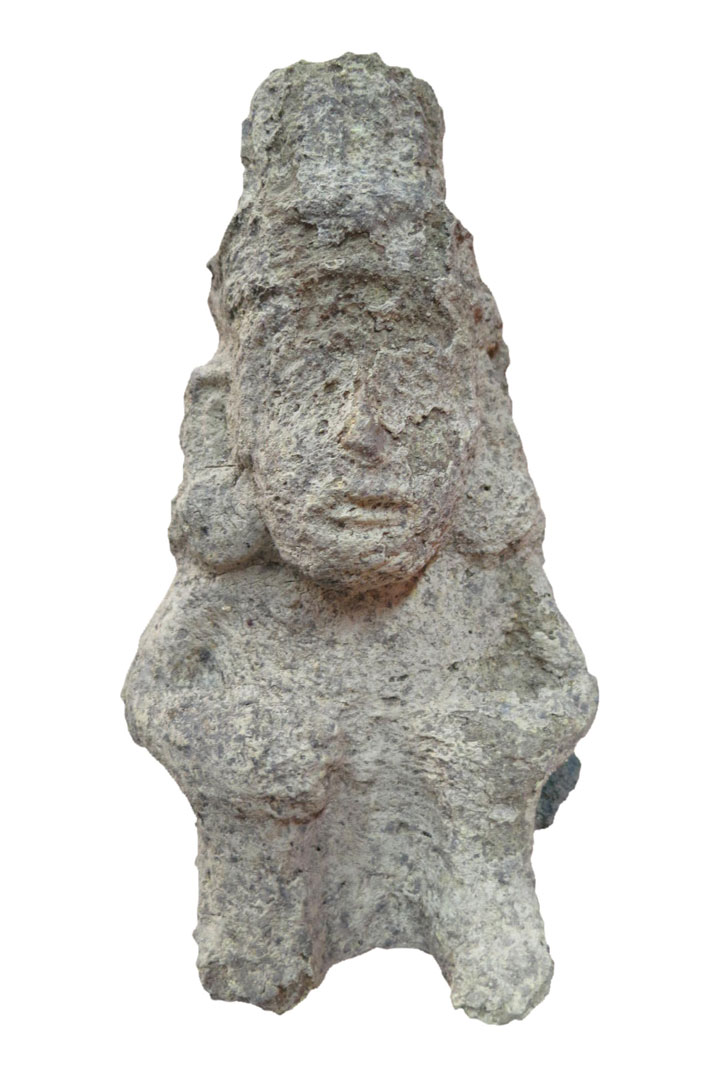 Nearby, researchers found a statuette of a seated woman made entirely of copal, an intensely aromatic tree resin that, more than 500 years later in the PAU laboratory, still emits the sweet, eucalyptus-like aroma that perfumed the dead. And a few feet away, in a contemporaneous deposit, archaeologists found 47 sahumadores, or clay incense pots, all meticulously arranged in rows and showing signs of intensive use. The long, protruding handles of some pots contained tiny pellets that, when the pots were moved, made a sound like a rattlesnake. Aztec priests are believed to have packed these incense pots with coal, copal, and other aromatic substances for use in ceremonies that filled the senses and masked the odor of death. “They used incense to sweeten the air, but also to purify the space and please the gods,” says Lorena Vázquez, a PAU archaeologist. According to Vázquez, the pots also held some kind of protein, possibly human blood.
Nearby, researchers found a statuette of a seated woman made entirely of copal, an intensely aromatic tree resin that, more than 500 years later in the PAU laboratory, still emits the sweet, eucalyptus-like aroma that perfumed the dead. And a few feet away, in a contemporaneous deposit, archaeologists found 47 sahumadores, or clay incense pots, all meticulously arranged in rows and showing signs of intensive use. The long, protruding handles of some pots contained tiny pellets that, when the pots were moved, made a sound like a rattlesnake. Aztec priests are believed to have packed these incense pots with coal, copal, and other aromatic substances for use in ceremonies that filled the senses and masked the odor of death. “They used incense to sweeten the air, but also to purify the space and please the gods,” says Lorena Vázquez, a PAU archaeologist. According to Vázquez, the pots also held some kind of protein, possibly human blood.
A more grisly find awaited archaeologists a few feet away—the skulls, jawbones, and vertebrae of about 500 people, including at least 10 children, in two tightly packed deposits. Before they were buried under an altar, the bones had been painstakingly prepared. They were stripped of their flesh and, judging from weathering stains, dried outdoors before burial, says María García Velasco, a PAU conservator. “These people weren’t thrown there like garbage,” she explains. “They were treated carefully, as befitting a ceremonial burial.” Surprisingly, Velasco adds, none of the skeletons analyzed thus far shows any sign of major trauma. PAU director Raúl Barrera believes that all the remains were buried at roughly the same time, and that they were all related to a single ceremonial event. Since both the human remains and the sahumadores were found under a stone-and-stucco floor, the event may have been a “closure” ceremony in which a part of the temple was built over and buried.
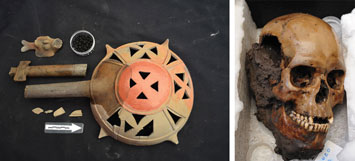 Looming over the deposit was a 40-foot-wide circular platform carved with stone serpent heads, their mouths agape. Historical sources speak of the platform, or cuauhxicalco, as the place where the remains of the Aztec rulers were publicly cremated. Their ashes were then placed in ceramic urns and buried. A few feet away from the cuauhxicalco, Barrera found the withered trunk of an oak tree that grew in a kind of large flowerpot. Spanish accounts mention ceremonial trees planted near the Templo Mayor festooned with strips of colorful paper, and, according to Barrera, this was surely an example. Taken together, the bones, the tree trunk, the serpents’ heads, and the thousands of smaller artifacts that have been found are creating a rich picture of ceremonial life in the Aztec heyday.
Looming over the deposit was a 40-foot-wide circular platform carved with stone serpent heads, their mouths agape. Historical sources speak of the platform, or cuauhxicalco, as the place where the remains of the Aztec rulers were publicly cremated. Their ashes were then placed in ceramic urns and buried. A few feet away from the cuauhxicalco, Barrera found the withered trunk of an oak tree that grew in a kind of large flowerpot. Spanish accounts mention ceremonial trees planted near the Templo Mayor festooned with strips of colorful paper, and, according to Barrera, this was surely an example. Taken together, the bones, the tree trunk, the serpents’ heads, and the thousands of smaller artifacts that have been found are creating a rich picture of ceremonial life in the Aztec heyday.
Temple of Quetzalcoatl
By ROGER ATWOOD
Monday, June 09, 2014
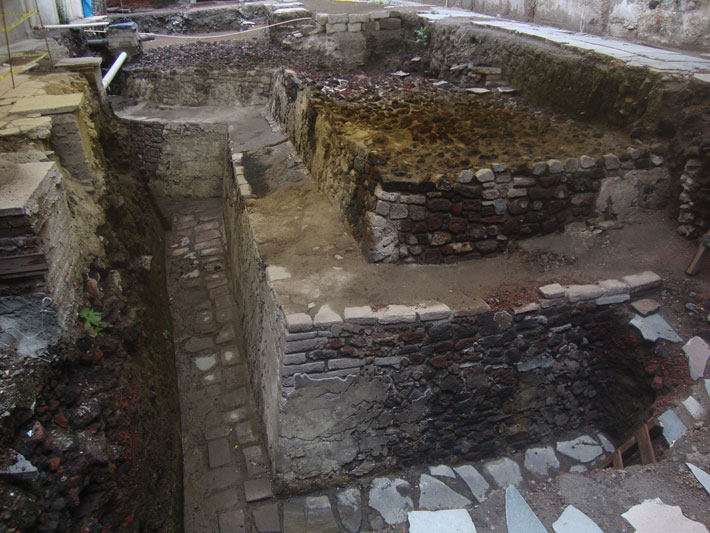 Archaeological sites in Mexico City have street addresses, not GPS coordinates, as sites tend to elsewhere. At this particular address, behind the green door, next to the Calmécac, archaeologists uncovered the Temple of Ehécatl-Quetzalcoatl, a structure dating from about 1450. The temple, whose distinctive, round shape was described by Spanish priest Bernardino de Sahagún, was located about 80 feet north of where Spanish colonial maps had originally shown it to be. Ehécatl was a wind god sometimes depicted as a version of Quetzalcoatl, the feathered serpent who had already been worshipped in central Mexico for more than 1,000 years by the time Tenochtitlan was founded in 1325. In fact, snake imagery abounded at the temple in antiquity. Spanish chroniclers described the building as having a conical roof made of straw, resembling a coiled snake. To enter, worshippers passed through a stone arch carved to resemble a snake’s mouth, complete with fangs. The Spaniards associated serpents with the Garden of Eden story, regarding the reptiles as evil, and usually destroyed snake images wherever they saw them. But, if the temple’s snake arch wasn’t destroyed by the Spaniards, it may still lie buried beneath a row of buildings behind the Metropolitan Cathedral, awaiting discovery.
Archaeological sites in Mexico City have street addresses, not GPS coordinates, as sites tend to elsewhere. At this particular address, behind the green door, next to the Calmécac, archaeologists uncovered the Temple of Ehécatl-Quetzalcoatl, a structure dating from about 1450. The temple, whose distinctive, round shape was described by Spanish priest Bernardino de Sahagún, was located about 80 feet north of where Spanish colonial maps had originally shown it to be. Ehécatl was a wind god sometimes depicted as a version of Quetzalcoatl, the feathered serpent who had already been worshipped in central Mexico for more than 1,000 years by the time Tenochtitlan was founded in 1325. In fact, snake imagery abounded at the temple in antiquity. Spanish chroniclers described the building as having a conical roof made of straw, resembling a coiled snake. To enter, worshippers passed through a stone arch carved to resemble a snake’s mouth, complete with fangs. The Spaniards associated serpents with the Garden of Eden story, regarding the reptiles as evil, and usually destroyed snake images wherever they saw them. But, if the temple’s snake arch wasn’t destroyed by the Spaniards, it may still lie buried beneath a row of buildings behind the Metropolitan Cathedral, awaiting discovery.
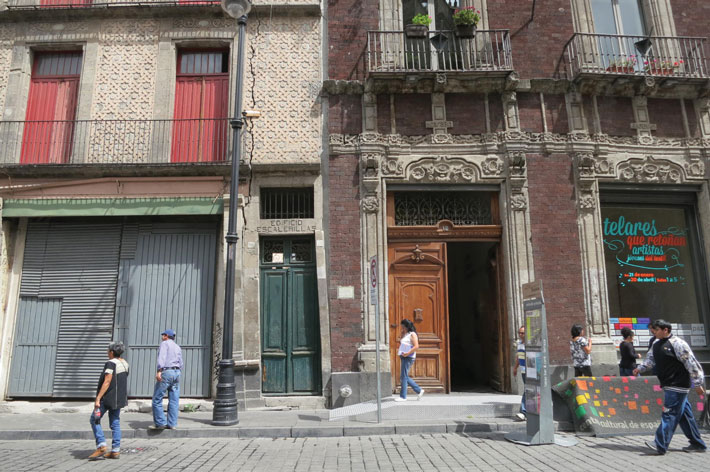 Excavation has shown that the Guatemala Street temple was bordered by a long outer wall, which the modern street directly above it follows exactly. This is no coincidence, but rather evidence that the Spaniards stuck closely to the original Aztec urban grid when they built their own city on the ruins of Tenochtitlan. Modern avenues also run along the same lines as causeways that once connected the ancient island city to the mainland.
Excavation has shown that the Guatemala Street temple was bordered by a long outer wall, which the modern street directly above it follows exactly. This is no coincidence, but rather evidence that the Spaniards stuck closely to the original Aztec urban grid when they built their own city on the ruins of Tenochtitlan. Modern avenues also run along the same lines as causeways that once connected the ancient island city to the mainland.
School of the Ancient Elite
By ROGER ATWOOD
Monday, June 09, 2014
In 1985, an earthquake measuring 8.1 on the Richter scale killed some 10,000 people and destroyed or compromised thousands of buildings in Mexico City. Some of those buildings happened to have been standing over Aztec civic and holy sites. More than two decades later, after workers demolished a building rendered structurally unsound by the quake, archaeologists dug down and found the ruins of an elite school near the Templo Mayor. Known as the Calmécac, which in the Nahuatl language spoken by the Aztecs means “school,” the complex was where Aztec nobility sent their children to be trained in war and worship. “The school’s proximity to the Templo Mayor shows the elite’s concern for educating young men for power,” says Harvard historian David Carrasco. The emperor Moctezuma II himself was a graduate.
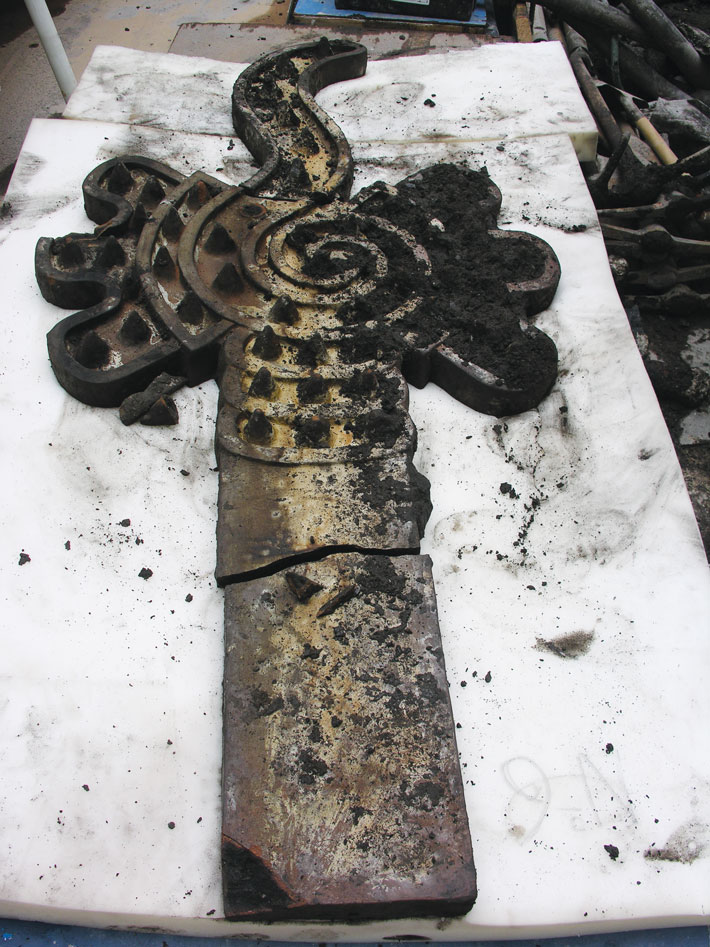 An enormous structure in antiquity, even larger than the Templo Mayor, the school had a courtyard whose roof was adorned with a row of spiral ornaments representing snails, which were associated with the rain god Tlaloc. Spanish colonial-era drawings had suggested these adornments were small, even dainty, decorative touches. But when archaeologists discovered them, the ornaments actually stood a monumental eight feet tall and must have been visible from all over Tenochtitlan. Of the seven found by archaeologist Raúl Barrera, all had been removed in antiquity from their rooftop perches and laid below a floor. By the time the Spaniards arrived, they had been replaced with similar ornaments that the Spaniards later destroyed, of which no traces have been found. Since their rediscovery, the Calmécac roof ornaments have become one of the most distinctive motifs of ancient Mexico. Excavation at the Calmécac proved difficult. Eighteen feet beneath the city, the site continually flooded and had to have water pumped out, a problem that speaks to the city’s unusual geography. Tenochtitlan was built on a group of marshy islands in the center of Lake Tezcoco. These were gradually filled in with lines of tree trunks and soil using an ancient land-reclamation technique similar to that employed in Tenochtitlan’s contemporary city, Venice. As in Venice, canals crisscrossed the city. Archaeologists have found traces of some of them, as well as a pier that jutted into the lake in antiquity. Lake Tezcoco has been almost completely filled in over the centuries, but the soil underneath the city remains porous and damp, “like gelatin,” says archaeologist Eduardo Matos Moctezuma. Although the city has been gradually settling at a rate of up to 20 feet per century into the lake bed, not so the Templo Mayor, which was built on sturdy landfill. It is therefore sinking at a much slower pace, causing it to gradually “rise” relative to its surroundings such that it will, eventually, regain the 150-foot height it had in antiquity.
An enormous structure in antiquity, even larger than the Templo Mayor, the school had a courtyard whose roof was adorned with a row of spiral ornaments representing snails, which were associated with the rain god Tlaloc. Spanish colonial-era drawings had suggested these adornments were small, even dainty, decorative touches. But when archaeologists discovered them, the ornaments actually stood a monumental eight feet tall and must have been visible from all over Tenochtitlan. Of the seven found by archaeologist Raúl Barrera, all had been removed in antiquity from their rooftop perches and laid below a floor. By the time the Spaniards arrived, they had been replaced with similar ornaments that the Spaniards later destroyed, of which no traces have been found. Since their rediscovery, the Calmécac roof ornaments have become one of the most distinctive motifs of ancient Mexico. Excavation at the Calmécac proved difficult. Eighteen feet beneath the city, the site continually flooded and had to have water pumped out, a problem that speaks to the city’s unusual geography. Tenochtitlan was built on a group of marshy islands in the center of Lake Tezcoco. These were gradually filled in with lines of tree trunks and soil using an ancient land-reclamation technique similar to that employed in Tenochtitlan’s contemporary city, Venice. As in Venice, canals crisscrossed the city. Archaeologists have found traces of some of them, as well as a pier that jutted into the lake in antiquity. Lake Tezcoco has been almost completely filled in over the centuries, but the soil underneath the city remains porous and damp, “like gelatin,” says archaeologist Eduardo Matos Moctezuma. Although the city has been gradually settling at a rate of up to 20 feet per century into the lake bed, not so the Templo Mayor, which was built on sturdy landfill. It is therefore sinking at a much slower pace, causing it to gradually “rise” relative to its surroundings such that it will, eventually, regain the 150-foot height it had in antiquity.
Once the remains of the Calmécac were stabilized, archaeologists discovered walls and wide staircases, some with ancient footprints still in their stucco surfaces. They also uncovered dozens of artifacts that hint at student life in A.D. 1500, including well-worn ceramic plates, a clay spoon, and flint and obsidian knives that probably had both practical and ceremonial uses. PAU director Raúl Barrera has excavated only a small corner of the ancient school because most of it remains beneath busy Donceles Street and its taco stands and cantinas. Digging any further would endanger those buildings’ foundations, he explains, “and then, instead of us excavating, someone would have to come excavate us.”
Last City of the Aztecs
By ROGER ATWOOD
Monday, June 09, 2014
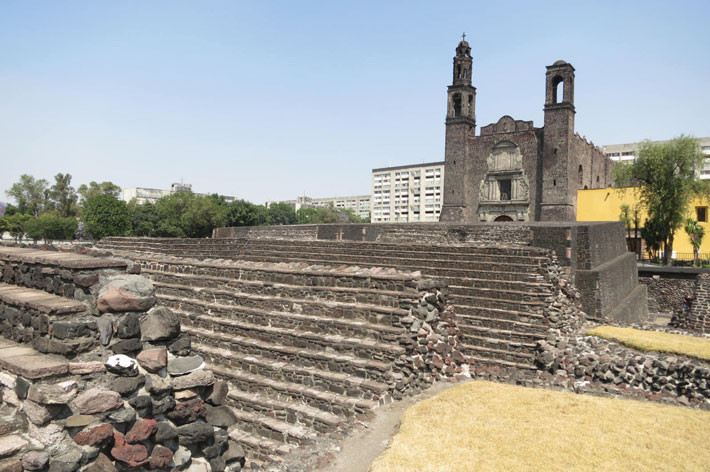
A half-hour walk north of the Templo Mayor, Tlatelolco was a rival Aztec city until it was absorbed into Tenochtitlan in 1473. Recent excavations have shown that Tlatelolco’s ceremonial complex was once almost as large and impressive as that of the main Aztec capital, although at the time of the Spanish conquest, the city was known mostly for its thriving market. Tlatelolco was the final redoubt of the Aztec emperor Cuauhtémoc before he was captured by Cortés in August 1521. Cortés later released Cuauhtémoc and allowed him to continue to rule but, fearing a conspiracy, had him executed in 1525. He was the last Aztec ruler.
Just over a decade ago, archaeologists made an intriguing discovery at Tlatelolco. Beneath a colonial church erected over Aztec foundations, they found a seven-foot-deep, 26-foot-wide basin that had been built on Cuauhtémoc’s orders. Known as a caja de agua, or “water box,” the basin was fed with water from Chapultepec Hill, some four miles away. A system of aqueducts ensured the city’s supply of potable water, as lake water was not suitable for drinking. This cistern was, perhaps, the last example of Aztec civic construction.
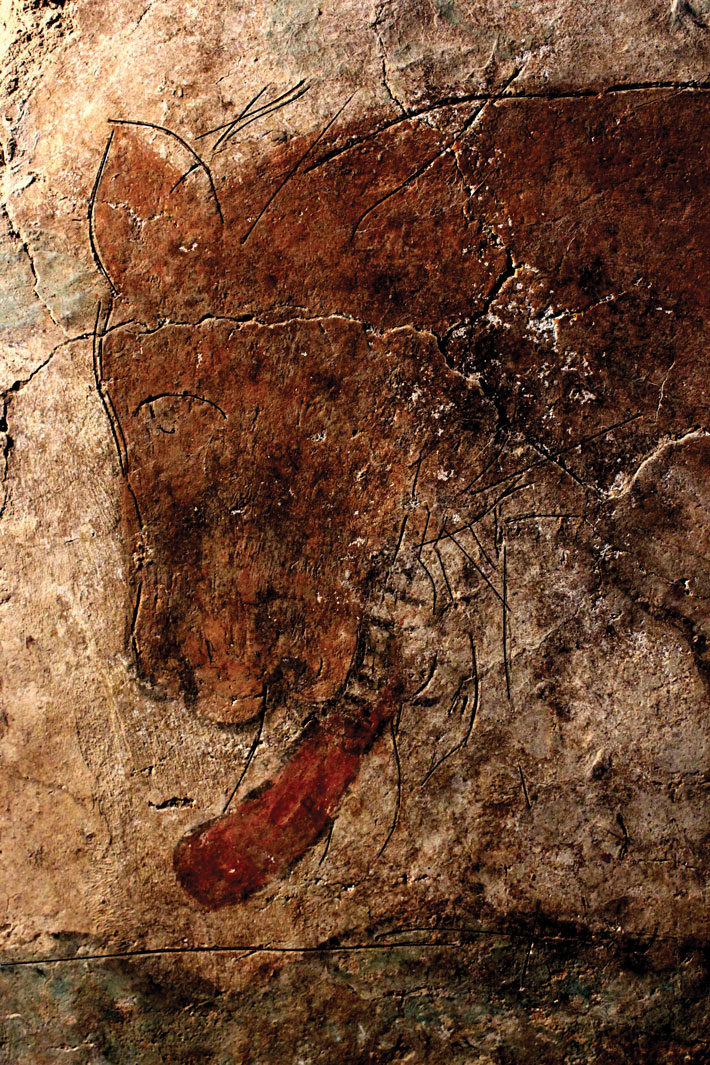 On the basin’s walls, archaeologists discovered murals, once brightly colored but now faded with age. Painted just as the Spaniards were consolidating their power, the frescoes are a unique hybrid of Aztec and Spanish themes. They show scenes of canoes on a lake, people fishing, ducks, reeds, water lilies, frogs, herons, and jaguars. In one scene, a fisherman casts a net while, at his feet, a coiled snake tries to eat a frog. Snakes and frogs had deep symbolic associations for the Aztecs, and were depicted in the basin in a naturalistic, European manner. “These murals were painted at the moment of the conquest. In a way, they show the encounter of the European and Mexican cultures,” says archaeologist Salvador Guilliem. Tlatelolco, where the Aztec world made its last stand, was thus also the scene of one of the initial artistic expressions of modern Mexico.
On the basin’s walls, archaeologists discovered murals, once brightly colored but now faded with age. Painted just as the Spaniards were consolidating their power, the frescoes are a unique hybrid of Aztec and Spanish themes. They show scenes of canoes on a lake, people fishing, ducks, reeds, water lilies, frogs, herons, and jaguars. In one scene, a fisherman casts a net while, at his feet, a coiled snake tries to eat a frog. Snakes and frogs had deep symbolic associations for the Aztecs, and were depicted in the basin in a naturalistic, European manner. “These murals were painted at the moment of the conquest. In a way, they show the encounter of the European and Mexican cultures,” says archaeologist Salvador Guilliem. Tlatelolco, where the Aztec world made its last stand, was thus also the scene of one of the initial artistic expressions of modern Mexico.
Advertisement
Advertisement
IN THIS ISSUE
Advertisement

Recent Issues
-
 May/June 2024
May/June 2024
-
 March/April 2024
March/April 2024
-
 January/February 2024
January/February 2024
-
 November/December 2023
November/December 2023
-
 September/October 2023
September/October 2023
-
 July/August 2023
July/August 2023
-
 May/June 2023
May/June 2023
-
 March/April 2023
March/April 2023
-
 January/February 2023
January/February 2023
-
 November/December 2022
November/December 2022
-
 September/October 2022
September/October 2022
-
 July/August 2022
July/August 2022
-
 May/June 2022
May/June 2022
-
 March/April 2022
March/April 2022
-
 January/February 2022
January/February 2022
-
 November/December 2021
November/December 2021
-
 September/October 2021
September/October 2021
-
 July/August 2021
July/August 2021
-
 May/June 2021
May/June 2021
-
 March/April 2021
March/April 2021
-
 January/February 2021
January/February 2021
-
 November/December 2020
November/December 2020
-
 September/October 2020
September/October 2020
-
 July/August 2020
July/August 2020
-
 May/June 2020
May/June 2020
-
 March/April 2020
March/April 2020
-
 January/February 2020
January/February 2020
-
 November/December 2019
November/December 2019
-
 September/October 2019
September/October 2019
-
 July/August 2019
July/August 2019
-
 May/June 2019
May/June 2019
-
 March/April 2019
March/April 2019
-
 January/February 2019
January/February 2019
-
 November/December 2018
November/December 2018
-
 September/October 2018
September/October 2018
-
 July/August 2018
July/August 2018
-
 May/June 2018
May/June 2018
-
 March/April 2018
March/April 2018
-
 January/February 2018
January/February 2018
-
 November/December 2017
November/December 2017
-
 September/October 2017
September/October 2017
-
 July/August 2017
July/August 2017
-
 May/June 2017
May/June 2017
-
 March/April 2017
March/April 2017
-
 January/February 2017
January/February 2017
-
 November/December 2016
November/December 2016
-
 September/October 2016
September/October 2016
-
 July/August 2016
July/August 2016
-
 May/June 2016
May/June 2016
-
 March/April 2016
March/April 2016
-
 January/February 2016
January/February 2016
-
 November/December 2015
November/December 2015
-
 September/October 2015
September/October 2015
-
 July/August 2015
July/August 2015
-
 May/June 2015
May/June 2015
-
 March/April 2015
March/April 2015
-
 January/February 2015
January/February 2015
-
 November/December 2014
November/December 2014
-
 September/October 2014
September/October 2014
-
 July/August 2014
July/August 2014
-
 May/June 2014
May/June 2014
-
 March/April 2014
March/April 2014
-
 January/February 2014
January/February 2014
-
 November/December 2013
November/December 2013
-
 September/October 2013
September/October 2013
-
 July/August 2013
July/August 2013
-
 May/June 2013
May/June 2013
-
 March/April 2013
March/April 2013
-
 January/February 2013
January/February 2013
-
 November/December 2012
November/December 2012
-
 September/October 2012
September/October 2012
-
 July/August 2012
July/August 2012
-
 May/June 2012
May/June 2012
-
 March/April 2012
March/April 2012
-
 January/February 2012
January/February 2012
-
 November/December 2011
November/December 2011
-
 September/October 2011
September/October 2011
-
 July/August 2011
July/August 2011
-
 May/June 2011
May/June 2011
-
 March/April 2011
March/April 2011
-
 January/February 2011
January/February 2011
Advertisement






